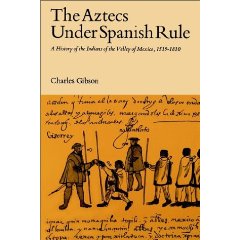Synopsis-- Charles Gibson, Aztecs Under Spanish Rule
Upon its publication in 1964, Aztecs Under Spanish Rule by Charles Gibson was recognized as a groundbreaking work of ethnohistory. First of all, Gibson establishes a pattern of pre-contact conquests in the Mexican valley. He writes, “For centuries, the rise and fall of tribes in the valley of Mexico had been governed by military victory and defeat, and the expansion and reduction of controlled areas had been reciprocal, complementary processes” (20-21). Still, he sees the Spanish conquest as a fundamental break with the past, characterized by resource depletion and the exploitation of indigenous people.
Gibson begins with an exploration of the geography and archaeology of the central Mexican valley. Next, he discusses the pre-contact patterns of conquest, in which the Mexica defeated the rival tribal power at Tenochtitlan in the 1400s, and the anti-Mexica politics of the years preceding the arrival of Cortés. Gibson points out that the Tlaxcalans attacked Tenochtitlan two years before they would repeat the process as Spanish allies. (12-18)
After a chapter on the fate of large tribal units after the militaristic phase of the conquest, Gibson discusses towns. Cabaceras, or “head towns” in Spanish, contained subunits called sujetos, or communities owing tribute to the cabaceras. These were intended to replicate pre-contact divisions of empire, and Gibson argues, “the irregularities were of Indian, not of Spanish origin” (47). He sees the late eighteenth-century decline of the cabecera-sujeta system as “Indian yielding to Spanish institutions,” or the “rejection of Indian institutions” (57).
Chapter Four discusses the encomienda and corregimiento. The Spanish crown granted an area of tribute-collecting in the encomienda, and Gibson emphasizes Spanish abuses of the system, saying that the mid-sixteenth century escheatment of the encomiendas was due to Indian resistance as much as restrictions by the crown (62-4). After the 1530s the coregimiento functioned as an alternative to the encomienda, with Indians placed under the jurisdiction of the crown and beneath the supervision of a salaried officer called the encomendero, who earned much of his income from extralegal manipulation of the situation.
Gibson has mined the archives for colonial documents and utilizes traditional sources like the chronicles of Gómara and the letters of Cortés. He also takes advantage of numerous secondary sources and new information from, for example, radiocarbon dates. His work surpasses what came before it and breaks new ground that allows James Lockhart and others to pursue important social history.
Still, Gibson does not escape the Black Legend. He writes, “The Black Legend provides a gross but essentially accurate interpretation of relations between the Spanish and the Indians” (403). Because of his identification with the Black Legend, Gibson highlights both discontinuity with the past and Indian “resistance” (which Lockhart has revealed to be a tricky concept, indeed). He sees “a record of deliberate sadism” (403) and one-sided exploitation and manipulation, and ends with the assertion that because they were so desolated, “few peoples in the whole of history were more prone to drunkenness than the Indians of the Spanish colony” (409).
To summarize, Gibson offers a very useful discussion of pre-Columbian politics and provides illuminating glimpses into early colonial organization and government. Aztecs Under Spanish Rule was an important book that laid a foundation for future research.

